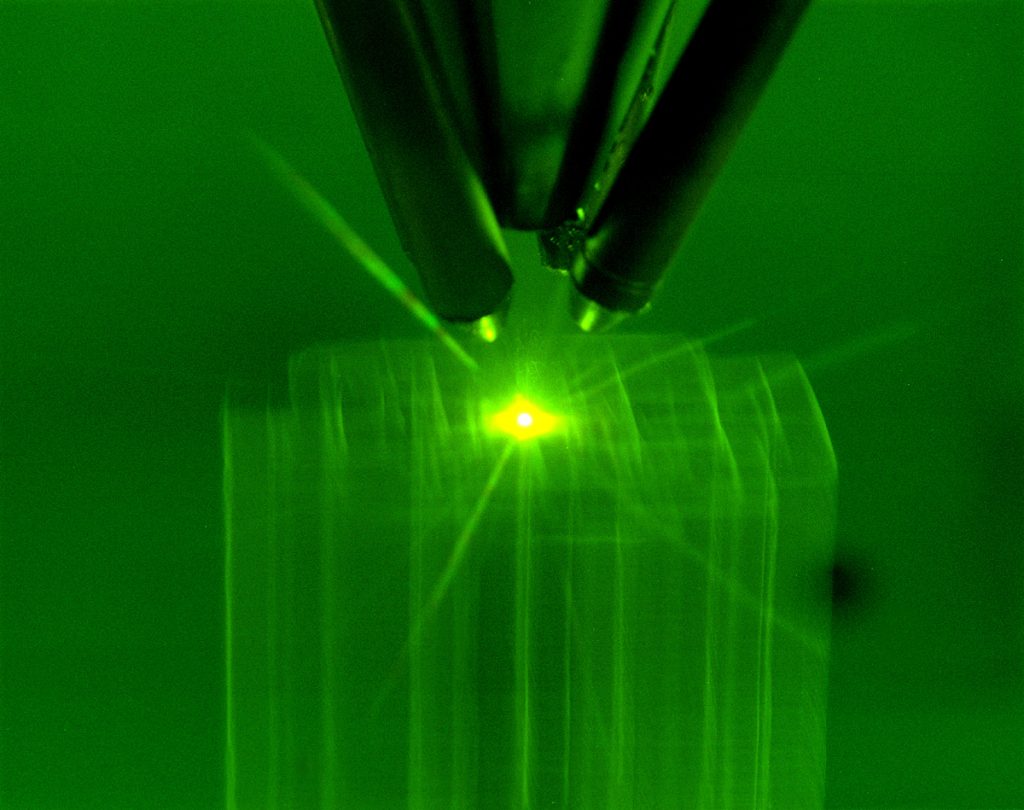
ALBUQUERQUE, N.M. — Commercialization of a possibly pivotal manufacturing technology is the goal of 10 companies teamed in a $3 million, two-year agreement with Sandia National Laboratories.
LENS® — Laser Engineered Net ShapingTM — uses computer-controlled lasers that, in hours, weld air-blown streams of metallic powders into custom parts and manufacturing molds.
The technique produces shapes close enough to the final product to eliminate the need for rough machining.
While the technology has worked in Sandia’s laboratories, the purpose of the Cooperative Research and Development Agreement (CRADA) is to produce an industrial tool that works automatically, robustly, and without constant supervision by a lab attendant.
When perfected, LENS should provide CRADA companies a lead of several weeks in bringing to market new products ranging from toys to tools, as well as the capability to quickly vary the shapes and materials of products as market conditions shift.
Industry will contribute $1.2 million and $304,000 of in-kind services; the U.S. Department of Energy’s Technology Partnership Program, $1 million; and Sandia’s Laboratory-Directed Research and Development program, which funds speculative defense-related research, $500,000. Sandia is a DOE laboratory.
Members of the CRADA range from Fortune 500 companies to small, recently started ones. They are AlliedSignal, Inc.; Eastman Kodak Company; Hasbro, Inc.; Laser Fare, Inc.; Lockheed Martin Corp.; MTS Systems Corp.; Minnesota Mining and Manufacturing (3M) Co.; Optomec Design Company; Teleflex, Inc.; and Wyman-Gordon Company.
“Additional companies can join if their application receives the approval of all the partners,” says Jim Searcy, director of Sandia’s Manufacturing Technologies Center.
Profits already made
Because the CRADA team also will define the design of LENS commercial equipment, one or more of the membership may offer LENS equipment as a commercial product.
Dave Keicher, vice president of Optomec, is part of a small Albuquerque company that has opted to produce LENS as a commercial product.
The company intends to make sample parts on demand for potential customers to show what the technique can do and how quickly it can do it.
The 13-year-old company has had annual sales of $350,000 until this year, when requests for preliminary LENS technology drove sales to more than $1 million, including the sale of a LENS machine to Ohio State University for research purposes. Cost of the machines, he estimates, will be in the $350,00 to $500,000 range. The physical system is roughly eight feet long, eight feet high, and 3.5 feet deep.
“It’s pretty hot stuff,” he said.
While other universities and national laboratories are pursuing similar research (notably the University of Michigan and Los Alamos National Laboratory), the Sandia CRADA is the first large-scale partnership created in this field.
According to Dave Abbott, development manager for AeroMet, a subsidiary of MTS Systems Corp., “At AeroMet, we already have our own laser deposition process. But we’re planning on leveraging the technical resources of the LENS consortium to enhance our process in three basic areas: parameter development, system enhancement and software development.”

How is it done?
The purpose of LENS is to make small lots of high-density parts or molds, a difficult operation because high temperatures make it hard to form accurate, smooth objects from molten metals.
Nozzles each direct a stream of metal powder at a central point beneath them. Simultaneously, that point is heated by a high-powered laser beam. The laser and jets remain stationary while the model and its substrate are moved to provide continually new targets on which to deposit metal.
Project manager Clint Atwood explains how the technique works: “We slice a CAD [Computer-Aided Design] model in horizontal sections, then move the part beneath the laser as we add metal to fill in that layer.”
Says Duane Dimos, manager of Sandia’s Direct Fabrication Department, “The process produces materials with outstanding mechanical properties — very high strength and high ductility.” Another plus, he says, is the process’s ability to mix powder streams of different materials.
“Our goals are to make intricate material combinations in complex geometries out of hard-to-machine materials,” says Jon Munford, manager of the Mechanical Engineering Department.
According to Glen Lichtenberg, an Eastman Kodak mechanical process engineer, “We expect the new process to produce unique features in mold cavities [the business part of the mold], which will allow some competitive advantage.” In addition to film, the company, headquartered in Rochester, N.Y., makes a variety of processing equipment and optical devices.
Layers deposit sequentially — first on a substrate, and then on the built-up layers — until the desired cross-sectional geometry is completed with production of a three-dimensional metal product.
Problems to be worked out include “dimensional accuracy — the process isn’t quite precise enough,” says Atwood, “and achievement of a better finish on the metal.” The finished product now has a slightly corrugated surface.
LENS technology was initiated at Sandia in 1995 through a Laboratory-Directed Research and Development project because of the Labs’ interest in low-volume production of highly specialized nuclear weapons components. “Because Sandia’s defense program needs are so specialized, this technology is important for us, and should provide a powerful fabrication tool for complex shapes and materials,” said Sandia vice president Bob Eagan.
LENS extends earlier techniques of rapid prototyping and rapid manufacturing. Those earlier techniques, now a $1 billion industry, use lasers to heat plastics into liquid and then form prototypes from the plastic. That process decreased the waiting period from months to weeks between conception of an idea and its appearance as a product on the market.
“When LENS gets going, $1 billion will be a small number,” says Searcy.
Technical contact:
Clint Atwood, clatwood@sandia.gov, (505) 844-0816
